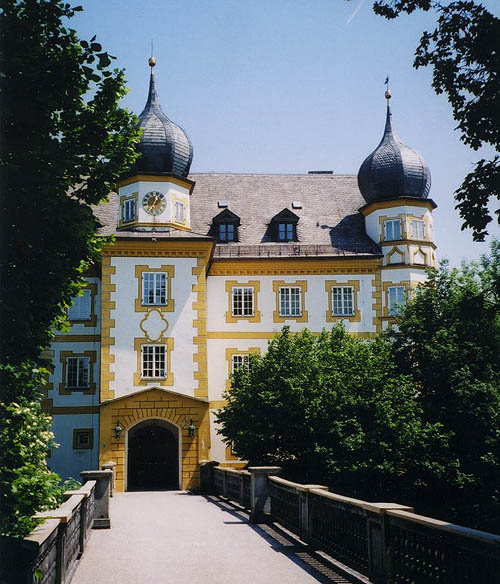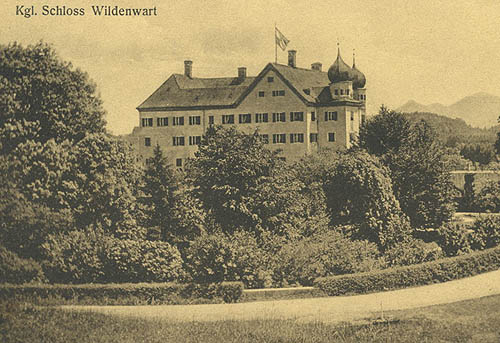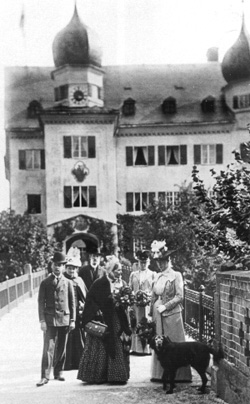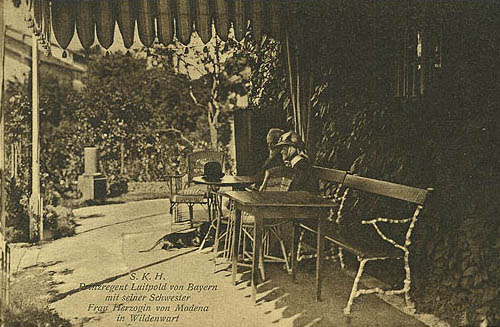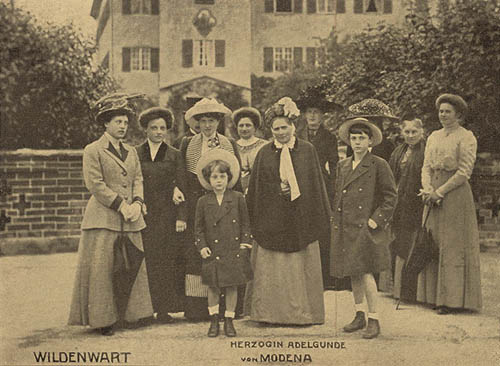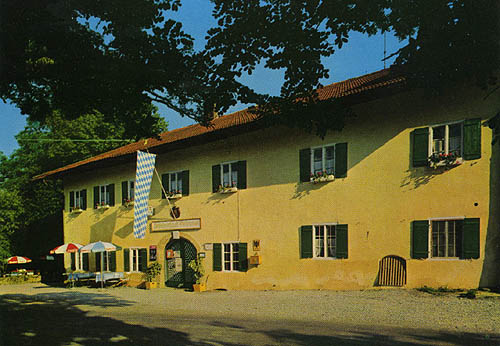 |
 |
 |
 |
 |
 |
 |
 |
 |
|
A Jacobite Gazetteer - Bavaria
Wildenwart - Schloss Wildenwart |
|
The village of Wildenwart is located about 80 kilometres south-east of Munich on the road between the towns of Frasdorf and Prien. At the centre of the village is Schloss Wildenwart. The castle is approached through a decorative wrought iron fence and then across a bridge, below which on both sides are formal gardens.
In 1862 King Francis I purchased Schloss Wildenwart from the Gewerkschaft Achtal-Hammerau (an iron mining company) for 42,500 guilders. 1 At the time the castle was in poor condition; King Francis immediately began its restoration. In August 1862 he opened the castle chapel to the general public. He had several pleasure buildings built in the grounds including a glass house and something called the "Pavillons". In 1863 he purchased the Waschhauser property and increased the size of the estate Gut Mönibuch.
King Francis and Queen Adelgunde spent many summer vacations at Schloss Wildenwart. 2 They held shooting parties here. Formerly Francis' coat-of-arms as Duke of Modena was placed above the entrance portal of the castle; it was removed in the most recent renovation. 3 At his death in 1875, King Francis granted in his will a life interest to his widow Queen Adelgunde to reside in the castle. She continued to spend her summers at the castle until her death in 1914. 4 In his will dated April 22, 1873, Francis had left the castle to the Infante Alfonso of Spain (younger son of his younger sister, Princess Marie Beatrix, wife of the Carlist claimant to the throne of Spain). But in a codicil to the will dated January 1, 1875, Francis left the castle to his niece Mary Theresa (later Queen Mary IV and III) on condition that she pay the sum of 80,000 guilders to her cousin the Infante Alfonso. In 1876 Queen Mary and the Infante Alfonso agreed to reduce this amount to 20,000 guilders. 5 Late on the evening of November 7, 1918, Queen Mary and King Ludwig fled from the Bolsheviks in Munich, arriving at Schloss Wildenwart in the early hours of the next day; they left here the same day and moved on to Hintersee near Berchtesgaden. They returned to Schloss Wildenwart on November 18, 1918. Queen Mary remained here for the next two and a half months until her death in February 1919. Her remains were placed in the castle chapel until they were moved to the Liebfrauendom in Munich in 1921. Princess Gundelinde married here in 1919. |
|||
In her will Queen Mary had granted a life interest to her husband King Ludwig to reside in the castle. This was his chief residence for the last two years of his life. The castle was set aside as an inheritance for several of Queen Mary's younger children: Prince Karl (died 1927), and his unmarried sisters Princess Hildegard, Princess Wiltrud (who lost her rights when she married in 1924), and Princess Helmtrud. 6
In 1923 the Bavarian State Government recognised the private ownership of the castle by the House of Wittelsbach. For many years Princess Hildegard and Princess Helmtrud lived here. Princess Hildegard had a fox terrier kennel at the castle. 7 Princess Hildegard died here in 1948 and Princess Helmtrud in 1977. Princess Helmtrud is buried at the cemetery of the nearby Christkönigskirche. After the death of Princess Helmtrud, Schloss Wildenwart became the residence of Prince Max and his family; they spent four years renovating the property. It is not open to the public, but lovely views of the facade can be obtained from the wrought iron gates. To the right of the castle is the former Schlosswirtschaft (the estate offices). Today this building is used as a restaurant. Above the entrance is a metal plaque with the coat-of-arms of King Francis I as Duke of Modena. In the forest to the south of the castle is a walking trail called "Herzogweg" (ducal way). 8
|
|||
|
Notes 1 Arthur Achleitner, Von der Umsturznacht bis zur Totenbahre: Die letzte Leidenszeit König Ludwigs III (Dillingen a. D.-München: Veduka, 1922), 180; "Frasdorfer Chronik" Dorfzeitung für die Gemeinde Frasdorf Nummer 57 (Juni 2005): 12. 2 Teodoro Bayard de Volo, Vita di Francesco V, Duca di Modena, 1819-1875 (Roma: Spithover, 1878), III, 540-542, 546, 549, 558, 563, 603. 3 The coat-of-arms is now in poor condition and is in storage at the castle. 4 Achleitner, 180. Alfons Beckenbauer, Ludwig III von Bayern, 1845-1921: Ein König auf der Suche nach seinem Volk (Regensburg: Friedrich Pustet, 1987), 282. 5 Max Oppel, Ludwig III, König von Bayern: Skizzen aus seiner Lebensgescichte (Prien: Verkehrsverband Chiemsee, 1995), 130. 6 Achleitner, 181; Oppel, 133. 7 Oppel, 139. 8 "Frasdorfer Chronik", 12. Image 1 (Facade): © Noel S. McFerran 2003. Image 2 (View from the west): postcard produced by August Zerle, München. Image 3 (Queen Adelgunda at Schloss Wildenwart, 1908): Hella Prinzessin von Bayern and Eugen Prinz von Bayern, Die Wittelsbacher und ihre Hunde (München: Hugendubel, 1995), 122. Image 4 (Queen Adelgunde with her brother Luitpold at Schloss Wildenwart): postcard. Image 5 (Queen Adelgunde at Schloss Wildenwart, circa 1911): postcard by Klischee-Anstalt, Müunchen. Image 6 (Schlosswirtschaft): postcard produced by Mohn, Gütersloh. |
|||
|
This page is maintained by Noel S. McFerran (noel.mcferran@rogers.com) and was last updated July 26, 2007. |
